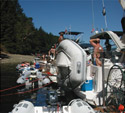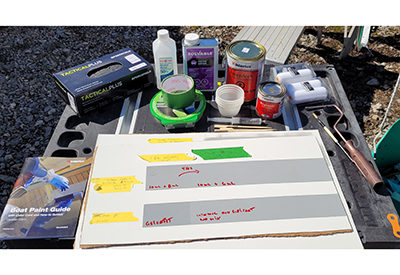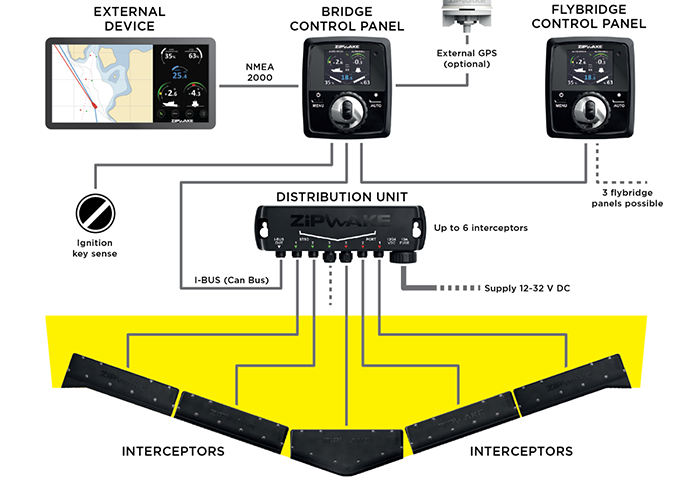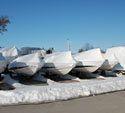Tenderizing Your Tender – An Easy Way to Get Around!

 I’ll never forget what a sad looking boat it was – a flaccid little inflatable with a wood floor, awash in perhaps 6 inches of slimy brown water that was slowly lapping into and out of the engine cover of the fairly new 9.9 Mercury outboard. The Merc’ had been left on its side on the floor. The dinghy was half under the pier and half in the rain, tied loosely at the back of the big boat’s slip, banging against the pilings 24 hours a day.
I’ll never forget what a sad looking boat it was – a flaccid little inflatable with a wood floor, awash in perhaps 6 inches of slimy brown water that was slowly lapping into and out of the engine cover of the fairly new 9.9 Mercury outboard. The Merc’ had been left on its side on the floor. The dinghy was half under the pier and half in the rain, tied loosely at the back of the big boat’s slip, banging against the pilings 24 hours a day.
A tough life like that will reward the dinghy’s owner with an equally tough time getting it running again – if ever. Treat your tender to a little tenderness and you will be rewarded with a versatile little boat that can excel at a wide range of tasks, all aimed at enhancing your enjoyment of the big boat lifestyle.
Dinghies
Our sad little dinghy should have been on davits, perhaps covered or up on its side so water couldn’t collect and with its engine on a mechanism that keeps it upright and safe.
Some boaters still tow their “dink” but the much-preferred way to handle it is on davits of some kind. And, there are many kinds! We’ll look at some of the most popular systems in a minute, but first, what do owners want to gain when they upgrade to a new dinghy and davit system?
In our travels, the number one answer was always “ease of use” – meaning that boaters want their dinghy ready to go with easy launch and fast retrieval. If you have to stop and inflate the dinghy, you are unlikely to use it much. You are even less likely to use it if the engine has to be removed each time. Yes – you can row, but not fast and probably not far.
Jamie Small at CO2 Inflatables in Oakville Ontario shared several valuable bits of advice when starting out or upgrading your tender. “Listen carefully to your dealer,” he said first. “There are limits in size and weight and therefore horsepower that can be safely carried on your swim platform or from your transom. There are structural considerations too and every boat is different. Next, get the largest and most powerful tender that you can safely carry. My rule of thumb is that without about 8 horsepower, a dinghy won’t plane a load and that means it will be slow. Slow means you can’t go far.”
We also learned that the business has changed quite a bit. The “RIBs”, rigid hull inflatable boats have come down in price and offer important advantages over an inflatable with a removable hard floor or an “air floor”. The hard planing surface and interior floor on a RIB performs better, runs faster and can carry greater loads. RIBS also have lots of sturdy mounting points for the davit system.
Not familiar with RIBs? This boat is basically a small but sturdy fiberglass hull shaped to hold an inflatable collar made of PVC or neoprene. The tubes only require about 6 psi of air pressure to be firm and functional. They make a soft seat, a non-tip way to step in and they give the RIB excellent weight carrying capacity.
The original inflatable boats were all “soft” with no fiberglass or aluminum bottom. Ones intended to carry an outboard had a hard transom though to manage the motor. These also can carry great weight for their size and can be deflated and stored in small spaces, which is a virtue, but horsepower and therefore performance levels tend to be modest.
In Canada, PVC construction in an inflatable boat will generally provide a 10-20 years of service depending mostly on sun and weather exposure. A neoprene or hypalon material is more expensive, but will potentially double the boat’s effective lifespan.
One key inflatable benefit is side stability for when you are stepping into the boat but some fiberglass dinghies deliver impressive side stability as well. Boston Whaler is a kind of gold standard in tenders starting at 11’4″ and a little over 400 lbs. hull weight; these are great performing and have full interior foam floatation for both strength and safety but the larger sizes mean they are better suited to larger yachts.
Other than Whalers, small fiberglass hard dinghies are available but we are seeing fewer of these as injection molded plastic boats like the Walker Bay 8 and Walker Bay 10 models prove to be light, strong and very resistant to damage.
Walker Bay also offers a hard dinghy that has an inflatable collar, in a way, combining the best of both worlds. These are still small boats though and they can carry only small engines.
When you get into the 12-foot RIBs like the Caribe DL models from 11-15 feet, the Zodiac Ribster models or Mercury’s Amanzi line that have a centre console, steering and controls, you can handle power like a 30 or 40 horse outboard. Then you have a boat that can carry several adults, a big load or even tow a skier.
As many owners comment after a season or two with a great new tender, “We are using the little boat more than the big boat!”
Whatever size or type attracts you, bear in mind that the inflatable tubes add a lot of buoyancy with little weight or size. A soft tube or rubrail will protect the tender and the big boat as well. The lifting eyes or harness and the strength of the mounting points are critical to long life. Another great feature is a self-bailer so you don’t have to worry about rainwater or swamping when being towed.
Davits
It is common for people to start off towing their dinghy; with a small keelboat, it may be both the most practical and the easiest solution. Power boaters travel at higher speeds though and they quickly discover that the dinghy needs to be towed around 50 feet back to keep it out of the wake and away from the rooster tail. A towed dinghy could flip in high winds and bad weather and there is a concern about another vessel cutting between the big boat and the dinghy. It is clearly best to carry the little boat on the big boat if you can, using a lift system, davits or some sort of cradle.
You rarely see a dinghy carried on the forward deck because it’s difficult to swing a dinghy down and off the side. Then, there is the question of how you safely get down into it, particularly in rough weather. It is better to have transom-mounted davits or a system on your swim platform.
Launching and retrieving the dinghy from a swim platform where you are almost at water level, on a large flat surface and probably with a safe non-skid texture, is the best and safest route. A particularly popular swim platform solution comes from Sea Weed Marine Products who have applied for patents for their Tend’r Rollers system.
Beautifully machined from polished stainless steel, this is like a roller trailer for your swim platform – drive up, get out on the swim platform and then attach the winch strap to the bow eye and start cranking. The vee-shaped rollers centre the dinghy, roll it up fairly easily on non-marking rollers and hold the dinghy securely with tie-down straps. The dinghy rolls back into the water just as easily.
If cranking isn’t your thing, get the electric version. The Tend’r Rollers are easily removable to keep your swim platform clear for swimming at the anchorage.
For boats that have a transom or shape that would not facilitate the Tend’r Roller system, you could get the very customizable davits from Atkins & Hoyle. They have different models and each can be adapted to your boat’s unique shape but they attach to the dinghy and lift it, level and straight up. It launches the same way.
“Level” has become very important. Today, most outboard motors are 4-stroke units and that means they have a crankcase containing oil (just like your car does). If a 4-stroke gets tilted at too great an angle, the oil can pour slowly out the valves in the head. It is best to keep the engine level and hanging vertically. Avoid laying one on its side unless it was designed to do that (and some are).
Weaver Marine Products and Sea Wise both offer systems that address this issue head-on. These systems include a transom bracket that the outboard mounts on. The dinghy lift brackets on the big boat attach to the dinghy transom bracket and as you crank the boat up onto the platform, it hinges the engine and transom bracket together, holding the dinghy securely up on its side but carrying the engine level and vertical – very innovative!
Most of the davits and hardware companies will do custom work. Companies like Stainless Outfitters have a line of arches and davit equipment but each installation is different. What hardware is needed depends on many factors, like how and where the transom is reinforced, what engine room systems may have been mounted on the inside of that transom and of course, what tender the owners wants, what that tender weighs and so on.
That takes us full circle to Jamie Small’s comment at the start of this article, “Talk to your dealer…” They have probably done many dinghy and davits installations, perhaps several on boats like yours and they can help you get the best little ship and the easiest launch and retrieval system your budget allows.
That way, both your boats will treat you to a little extra tenderness!





























